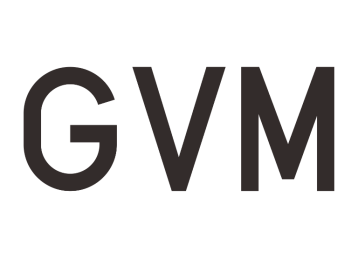All the links to listen to the panels
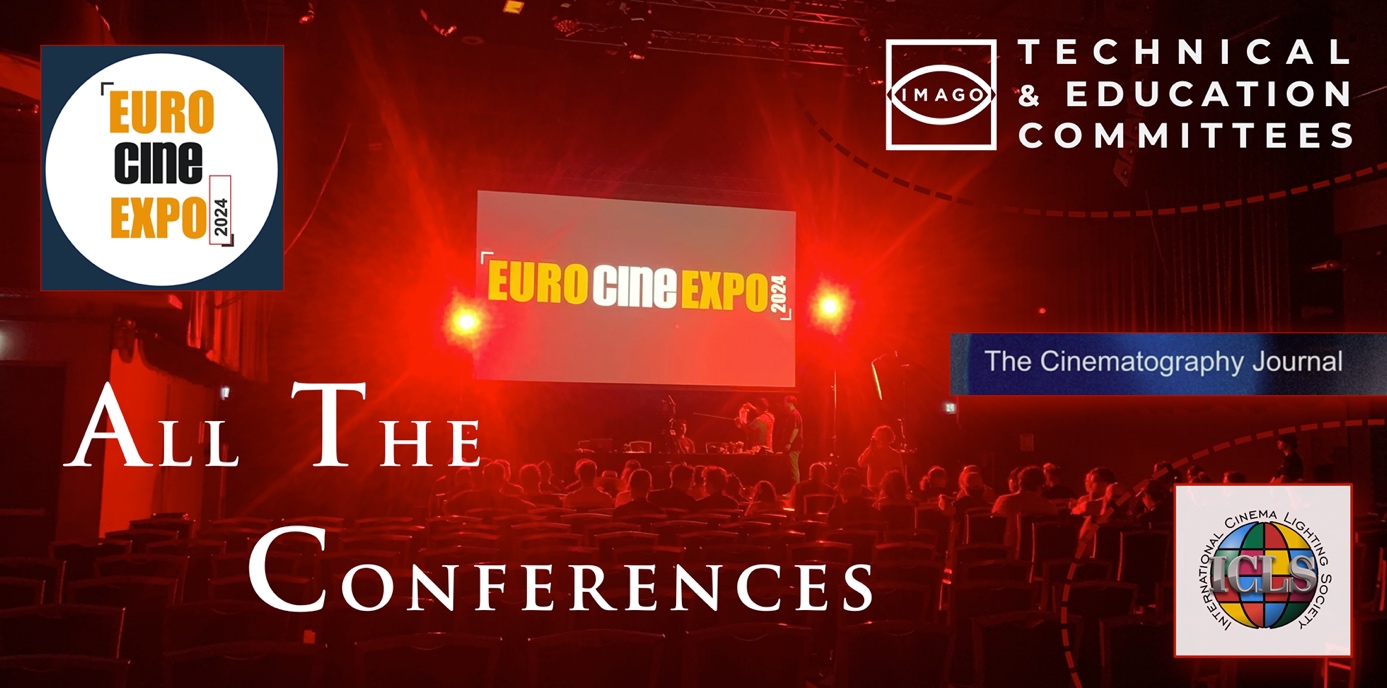
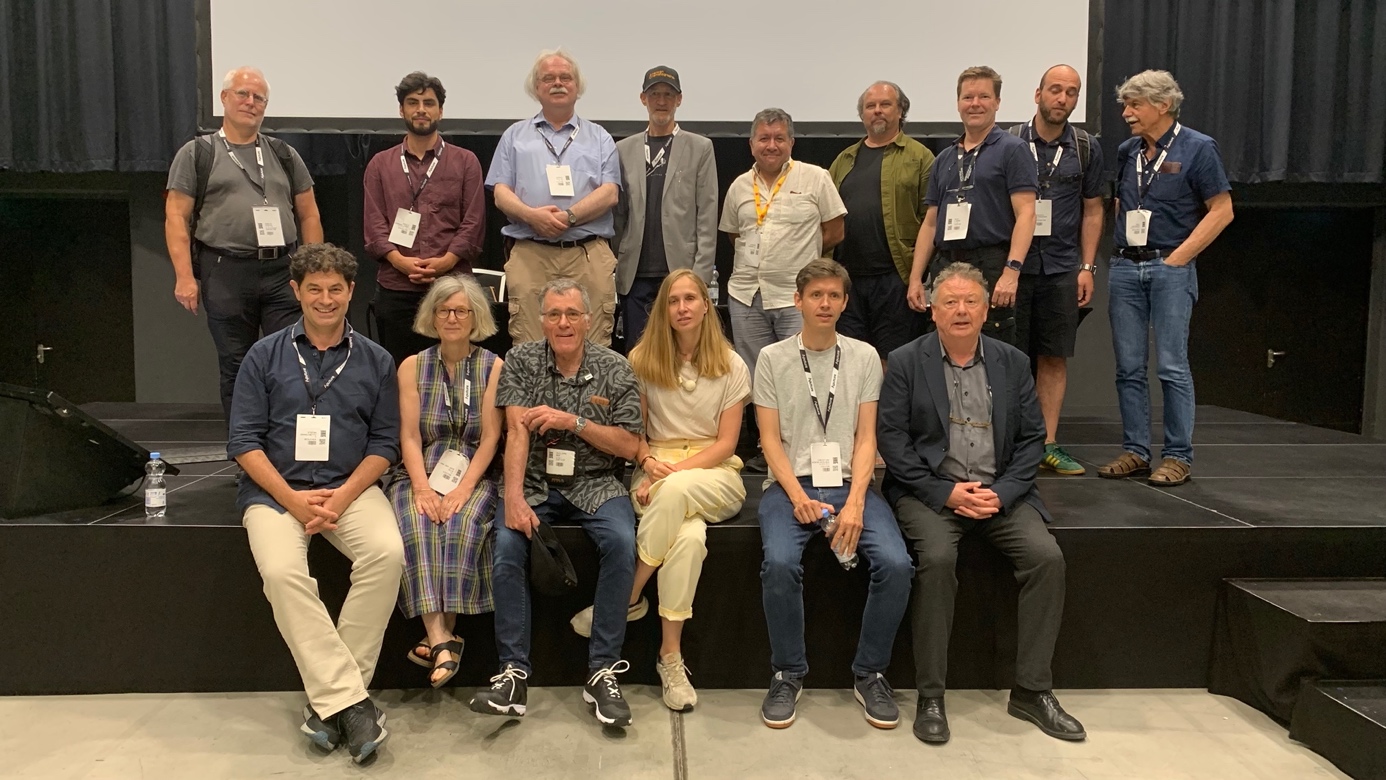
FIRST ROW FROM LEFT TO RIGHT:
Stefan Grandinetti BVK, ITC, Professor HdM University. Ella van den Hove SBC, IEC chair, Professor INSAS. Philippe Ros, AFC – ITC co-chair. Bojana Andric, SAS, ITC, IMAGO Vice-president. Christian Wieberg-Nielsen, colorist FNF, ITC. Tony Costa, AIP.
SECOND ROW FROM LET TO RIGHT:
Markus Stoffel, President BVK. Danilo Miranda Cares, Professor Lusófona University. Kommer Kleijn, SBC, ITC. Roberto Schaefer, ASC, AIC, ITC. Vincenzo Condorelli, AIC, ITC. Rauno Ronkainen, FSC, ITC, Professor Aalto University. Alex linden, FSF, ITC, IMAGO General Secretary. Daniele Siragusano, Image engineer FILMLIGHT, ITC. Rolf Coulanges, BVK, ITC.
Download the report below:
Report – IMAGO Education & Technical Committees present at the EURO CINE EXPO 204 in Munich 296.95 KB 37 downloads
…At the end of June, the third edition of this international exhibition of cinematographic equipment and technologies was held in Munich. The event is organized by Claire and Rob Saunders, who have long been in charge of other international events and pavilions. To accompany the exhibition, they wanted to create a major symposium from the outset.
Supported by an Expo, but the two organizers have gone to great lengths to invite a host of professionals from many different countries. They felt there was a real need for a platform for designers and technicians to meet and exchange ideas in this part of Europe.
To this end, Claire and Rob called on the IMAGO Technical Committee (ITC) for the first edition in 2022, which proposed two conferences. In 2023, the ITC organized 6 conferences, and this year the ITC oversaw 16 conferences and panels with Claire and Rob.
Within these 16 sessions, the ITC proposed to the IMAGO Education Committee chaired by Ella van den Hove (SBC) to take two slots.
It included a very interesting approach by cinematographer Yu-Lun Sung to virtual production, which he believes should be critically assessed from a decolonial perspective.
Maarten Coëgnarts, Assistant Professor Film EU, LUCA School of Arts & University of Antwerp, Stefan Grandinetti BVK (Professor at the Stuttgart Hdm), Tony Costa, AIP & Rauno Ronkainen FSC Professor at the Aalto University, Helsinki) took turns sharing their experiences of teaching cinema. Particular attention was paid to CITO, a publication from the International Joint Research group: CInemaTOgraphy in Progress which provides relevant news, projects, articles and events on the art of cinematography and filmmaking.
https://cinematographyinprogress.com/index.php/cito
But we recommend watching the results of the pedagogical experiment led by Ella van den Hove: two astonishing short films:
Remanance
https://drive.google.com/file/d/1uYbD2ZagWbzF-4iMVmkWS_lq0TC1tgSB/view?usp=sharing
’Chagrin d’amour de poissons rouges (Goldfish heartbreak)
https://drive.google.com/file/d/1YfMdOvLPyN8xucuPoUe7av5S4_h39wKF/view?usp=drive_link
For the ITC
From panels on HDR, ACES 2.0, Image Base Lighting, mixed reality, metadata, judder, immersive cinema, aspect ratio, laser vs xenon projection, shooting 35 mm for virtual production, to lectures on the numerous breakthroughs in VFX during the making of the film ”Comandante”, to the relationship between actors, directors and cinematographers, the ITC has given a large broad overview on the profession.
Collaboration between ICLS & ITC
This year the ITC has started a long-term collaboration with the gaffer’s society: the ICLS (International Cinema lighting Society). With Ediola Pashollari, ICLS executive director and Ville Pentilla gaffer, the ITC organized the conference ”Gaffers & Cinematographers facing up to LEDs”.
Due to the importance of the Powerpoint presentation, we will shortly be sharing the video link to the special ‘Research Outcome on LEDs’ meeting that the ICLS and ITC organised at the beginning of September.
But that’s only part of the 32 panels and lectures given between June 28 and 29 in 3 specially equipped rooms at the Motorworld center (a paradise for car lovers…).
”The Art of Cinematography” with Dion Beebe ACS, ASC, was a great success and we also recommend for German speaking listeners the presentation
https://youtu.be/f7dvqGkzmBs
”LED Lighting & Color” given by Peter C. Slansky, Professor of the Department of Technology at the HFF Munich.
https://youtu.be/0xERyKhnCRI
We hope that next year, all the IMAGO committees will be represented at the symposium of this important exhibition.
Euro Cine Expo delivers a unique opportunity for everyone in the film industry. The organisers are dedicated to delivering a high level of content and learning, making this different from any other event in the world. They are also committed to continuing to offer ITC a platform to share their knowledge.
This mix of presentations, the global display of equipment and technologies, and in-depth analysis of our activities makes the EURO CINE EXPO the place to be for the film community.
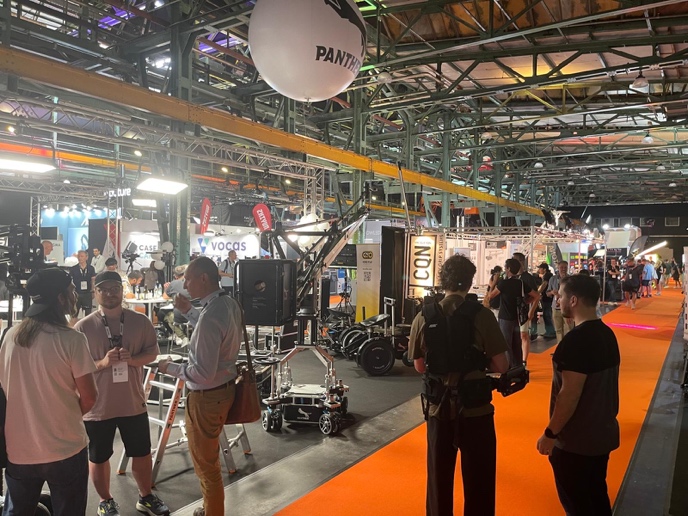
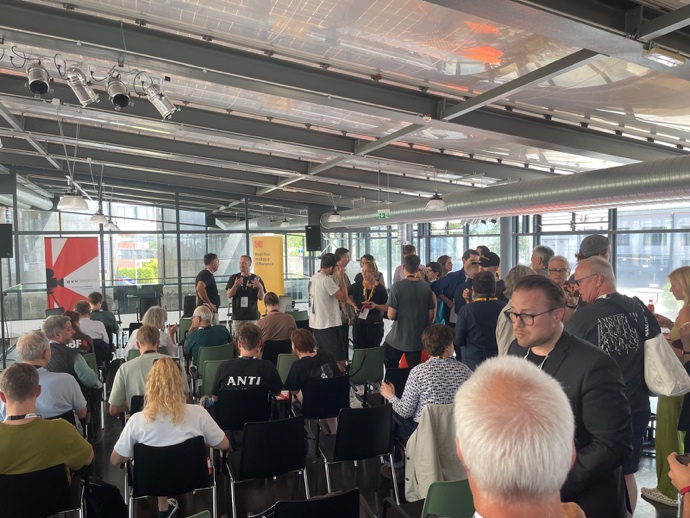
It is impossible to describe all the panels and conferences, so we propose to focus on what seemed to us the most striking:
Artificial intelligence and the movie community
Naturally, this panel on AI was a great success:
Moderated by David Stump (ASC, BVK, ITC co-chair), it brought together Tom Keller (BVK, SCS), Kommer Kleijn (SBC) Danilo Miranda Cares (cinematographer and professor at Lisbon’s Lusófona University, Daniele Siragusano (imaging engineer at FilmLight) and finally Roberto Schaefer (ASC, AIC).
It was a fascinating meeting on the future of our professions, with very different points of view, but marked by a real understanding of AI.
– Kommer Kleijn has been working on this hot topic for many years, and reminded us that AI is not a computer, and that we have real fears because, in his opinion, we are unable to control it.
– Daniele Siragusano showed the various advantages of AI in digital image processing.
– Roberto Schaefer recalled the staggering progress made in live dubbing of films with the intonation and lip movements of each actor. The direct consequence is that hundreds of sound dubbers will be out of work. He also notes. “If I want to stay active in the industry as a cinematographer, I need to understand how to use these tools and make sure they don’t use me”.
David Stump, who also works for the US government on this subject, underlined the phenomenal advances in rotoscopy that are condemning all the employees of the “rotofarms” in India, Vietnam and Thailand in the short term.
Please find video links of the session (For this first attempt, these sessions have been shot with only one camera, so consider them as sound podcasts)
1. Choosing colours for better integration of the virtual and physical worlds
2. A cognitive approach to cinematography
Speakers:
1 – Yu-Lun Sung Cinematographer, School of Arts and Creative Industries
Tim Kang ASC Associate member
Roberto Schaefer ASC, AIC
2 – Maarten Coëgnarts FilmEU, LUCA School of Arts & University of Antwerp
Summary:
In partnership with CITO (Cinematography in Progress) & the IEC (Imago Education Committee).
‘’Virtual Production (VP) that focuses on technological advancement and technical design, I argue should be critically appraised from decolonial perspectives. Decolonialisation, involving the democratisation of technological development and the dissemination of information through the internet, has the potential to shift power dynamics, challenge established paradigms, and value neglected cultures. In integrating Personal Colour Analysis (PCA), my research proposes an intercultural dialogue that can enable PCA practice to complement in future endeavours of optimisation in VP workflows, which could build and foster other sociotechnical imaginaries beyond the dominant research and development models for underrepresented groups in film and media industry”.
1. Cinematography education
2. Introduction to the on-line journal: CInemaTOgraphy in progress
Speakers:
1 – Ella van den Hove SBC, INSAS
Rauno Ronkainen FSC, Aalto University (Helsinki)
Stefan Grandinetti BVK, HdM University
2 – Tony Costa AIP, Lusofona University Lisbon
Yu-Lun Sung Cinematographer, School of Arts and Creative Industries UK
Stefan Grandinetti BVK, HdM University (Stuttgart)
Summaries:
1 – The target of this presentation is to share a pedagogical experience and show some nice examples with an eventual students’ participation.
This pedagogical experience involved a group of 10 students in cinematography just before their graduation. They will be required to choose an excerpt from an existing film soundtrack and create and execute a new visual interpretation. They will facing both technical and artistic responsibilities, directing their teams and actors.
2 – CITO is a group of researcher issued from the Education Committee of IMAGO. We expect to introduce our main activity, the journal, to the audience. We facilitate and promote research into the different aspects of cinematography, especially its role in narrative fiction film. As the art and craft of cinematography is little understood we want to research the storytelling capacity of moving images, and this to promote visual literacy. In this fast-paced age, the hunger of how to create emotions evoking images-and how it is perceived- is big.
A key objective is to build a bridge between film practice and film studies. The argument for tapping into the knowledge of cinematographers lies in the simple fact that since the existence of cinema, cinematographers, or cameramen as they were first known, were always there. Cinematographers have been there since the inception of the motion picture. Cinematography does not limit itself to techniques but includes the “development of the eye”, film history, the study of art history, optics and established techniques alongside the effects of digital workflow and other more recent developments in the digital domain. We want to investigate the link between the creation, the projection and the perception of visual media and its communication. https://cinematographyinprogress.com
IMAGO Technical commmittee
Challenges and nature of Mixed reality: how realities mixture may look real. Lighting approach
Speakers:
Aleksej Berkovic ITC co-chair
Fabian Wagner, ASC BSC
Roberto Schaefer ASC, AIC
Tim Kang ASC, Associate Member principal engineer for Imaging Applications at Aputure
Summary:
A discussion of innovative lighting technologies. Mixing light sources of a different nature for natural look of captured footage.
– Demand on light character control,
– Basic features and ways of keeping those as creative tools
– Successful harmony of physical and generated reality in visual storytelling
Automated metadata. The last place to look for saving money
Speakers:
David Stump ASC, BVK, ITC co-chair
Patrick Renner POMFORT
Summary:
’I always juxtapose automated metadata against what was done in the past, something that I call “meta paper.” The data regarding the lens, camera height, and tilt angle was all sort of estimated, written down on paper, and filed away in a notebook on a shelf somewhere in the editor’s room. When VFX or anyone else needed that data, someone had to go get the notebook, rummage through it, and find the piece of data that was needed.
If it’s automated and built into the files, you don’t have to bother anyone to get it, and it’s not generated by a human being so it’s not distrusted nor is it prone to error. I think automated metadata through the entire imaging pipeline will eventually save tons of money in film production.
In a time when producers think the only way to save money on a show is to beat up rental vendors and the crew for their day rate, that’s a lot of money’’
Understanding judder in motion imaging
Speakers:
David Stump ASC, BVK, ITC co-chair
Stefan Grandinetti BVK, HdM University
Henning Rädlein Head of digital workflow support, ARRI
Summary:
Judder is an annoying lurching from one frame to the next in a scene that happens when you pan or track the camera too fast. This will be an educational presentation on the mechanics of the phenomenon and how cinematographers can cope with the physics of digital cinema cameras shooting at 24fps
Image Based Lighting – IBL
Speakers:
David Stump ASC, BVK, ITC co-chair
Frieder Hochheim KINOFLO founder
Tim Kang ASC Associate Member
Tom Keller, SCS, BVK
Roberto Schaefer ASC, AIC
Summary:
Lighting an environment to be visually convincing has always been the prime goal for any cinematographer. In the past, we have used shortcuts like Poor Mans Process, or manually creating shadows, but now with Image-based Lighting (IBL), creating realistic and active subject lighting can be accomplished using video or computer generated assets. Image-Based Lighting (IBL)uses images displayed on LED set lights to produce realistic reflections and ambient lighting in a scene. It gives the cinematographer subtle lighting effects that help make the objects appear as though they naturally belong in an environment.
Sponsored by Sumolight
The VFX challenge of Comandante
Speakers:
David Stump ASC, ITC co-chair
Summary:
An Italian feature film project called Comandante, directed by Edoardo de Angelis, epitomises the paradigm shift in virtual production right now. The film is the true story of a World War II submarine commander, featuring ships and subs at sea and, of course, the ocean.
It can be hard to recognize breakthroughs as they are happening, but there were numerous breakthroughs in VFX during the making of Comandante.
Learning to very accurately undistort and redistort anamorphic lenses in real time was groundbreaking.
Presenting Near Real time meaningful composite shots to the Director on set was another breakthrough.
Preserving metadata through the entire workflow was a breakthrough.
Using AI tools to enable the technique we have dubbed “similar screen compositing” is another.
One breakthrough that cannot be emphasized enough is the positive collaboration of the camera crew, the VFX department, post production and VFX to make a quality film on a budget.
Shooting 35mm film for virtual production
Speakers:
Stefan Grandinetti BVK, HdM University
Luis Zappe Cinematographer
Sebastian Burk, Director and Virtual Production Supervisor
Samuel Ramm, Director
Tom Keller BVK SCS
Tim Kang ASC Associate Member
What happens when you combine 35mm film and LED-volumes? How does one integrate film into an entirely digital production environment with synchronization, color calibration and monitoring, and how can celluloid film benefit moiré, color rendering and the overall look on the other hand? In cooperation with ARRI, Studio L’Equipe, HYPERBOWL, SILBERSALZ, oh, boy! films and support by Mitch Boxrucker from KODAK, we shot a 2-minute narrative short-film to uncover the challenges and potential when combining the oldest and newest tools in the film-industry.
Luis Zappe is a Cinematographer and Gaffer from Bayreuth, Germany. He studied Audiovisual Media at Stuttgart Media University where he developed a keen interest in creating unique images. His fascination for new and unconventional lighting tools also led him to various virtual productions in the past few years.
Samuel Ramm (Director)
Samuel Ramm is a passionate storyteller working as a cinematographer and director, based in Stuttgart and working all over the world.
With his work he wants to tell stories that have not yet been told, give people a voice that has not yet been heard and reveal beauty that has not yet been seen.
In his creations, Samuel Ramm is constantly trying out new innovative tools such as virtual production or AI.
AMPAS – New ACES 2.0
Moderator:
Roberto Schaefer ASC, AIC
Speakers:
Alex Forsythe AMPAS & Steve Tobenkin AMPAS by Zoom
Eric Chérioux CST (French Higher Technical Commission for Sound and Images)
Miga Bär NSC Associate Member
AMPAS: Academy of Motion Picture Arts and Sciences – Oscars.org
Summary:
The latest update on the new ACES 2.O by the AMPAS (ACADEMY OF MOTION PICTURE ARTS AND SCIENCES
https://www.oscars.org/science-technology/sci-tech-projects/aces
Resolution and Image Quality in Immersive Cinema (and Giant Screen)
Speaker:
Pawel Achtel ACS
Moderator:
David Stump ASC – BVK – MITC – ITC co-chair
Summary:
A discussion on the need of high resolution for immersive cinema, Virtual Production, VFX or Giant Screen with Pawel Achtel, ACS inventor of the 9×7 camera.
https://www.newsshooter.com/2020/09/14/achtel-9×7-65-megapixel-motion-picture-camera
The Creative Triangle: Relationship between Actors, Directors and Cinematographers
Co-moderators:
Philippe Ros AFC, ITC co-chair & Roberto Schaefer ASC, AIC
Speakers:
Bob Swaim, Director, Scriptwriter, Producer By Zoom
Florian Froschmayer, Director
Laura Birn, Finnish actress By Zoom
Lara Mandoki, German actress
Bojana Andric, SAS, IMAGO Vice-president
Rauno Ronkainen, FSC, Aalto University
Markus Schott, BVK
Summary:
While the relationship between director and actor is well known, documented and emphasized in most acting schools, the relationship between actors, directors and technicians is barely explored. Actors almost never ask what lens is used on a camera. They rarely know the difference between a wide-angle and a telephoto lens and how this can interact with their own performance.
The panel will explore the relationship between the actor’s field of play and the camera’s field of view involving lenses, movements, eyelines as well as timing and continuity.
For the actors, it is important to understand the technical requirements imposed by the camera. For the director and the technicians understanding the rhythm and beats (segments) of a scene gives an entirely different approach to making the right decisions, especially for breakdown.
HDR – what was that again?
Speakers:
Dirk Meier Senior colourist – BVK – CSI
Felix Hüsken Senior colourist BVK – AAC – CSI
Florian Friedrich HDR Expert – CEO FF Pictures
Michael Hackl Content Engineer Dolby
Please find the link of Dirk Meier’s presentation:
https://www.digital-film-services.com/media/ECE.2024_HDR_print_small.pdf
Summary:
HDR – it came to stay, but where exactly and are there any news about it. High Dynamic Range was, as many other buzz words before, announced to be the next big thing in media entertainment and also promised TV manufacturers a huge advantage over classic cinema. Almost a decade later we’ll have a quick look at the current status of HDR deployment in Germany and Europe. Who is actually producing HDR content, and who is watching it.
In a small panel of experts from production to distribution we’ll discuss findings from a quick poll within Germany and our personal experiences and opinions.
Laser projection vs Xenon projection
Moderator:
Daniel Siragusano FILMLIGHT
Speakers:
Kommer Kleijn SBC
Eric Chérioux CST (French Higher Technical Commission for Sound and Images)
Christian Wieberg-Nielsen Senior colourist FNF
Tom Keller BVK SCS
Summary:
In recent years, the replacement of xenon projectors by laser projectors has had consequences for colourists, cinematographers and spectators. This conference aims to assess the main differences.
The AI and the movie community
Moderator:
David Stump ASC – BVK – MITC – ITC co-chair
Speakers:
Tom Keller, BVK, SCS
Kommer Kleijn, SBC
Danilo Miranda Cares, Professor Lusófona University and FilmEU
Daniele Siragusano FilmLight
Roberto Schaefer ASC – AIC
Summary:
Artificial Intelligence is already disrupting the music, film and television industries. What are the drawbacks, and what are the new opportunities for artists and businesses from using generative AI? Threats to business models and livelihoods loom large. Can AI be innovative, creative or is it just derivative? What are the capabilities of AI? What are the copyright implications for artists? And how will industry and governments regulate this technology?
Other sessions
Pawel Achtel Camera
Dedo Lights
Age discrimination (German)
Find the right Colour – A camera & lighting colour testing seminar – Aputure
Canon (in German)
Unleashing Creativity – The Sony Burano in action
Innovative solutions for green film production
Universal tilt & shift & swing system ze Freelensing a new language
”Beyond belief: Fact or fiction” – Rebooting a cult classic

